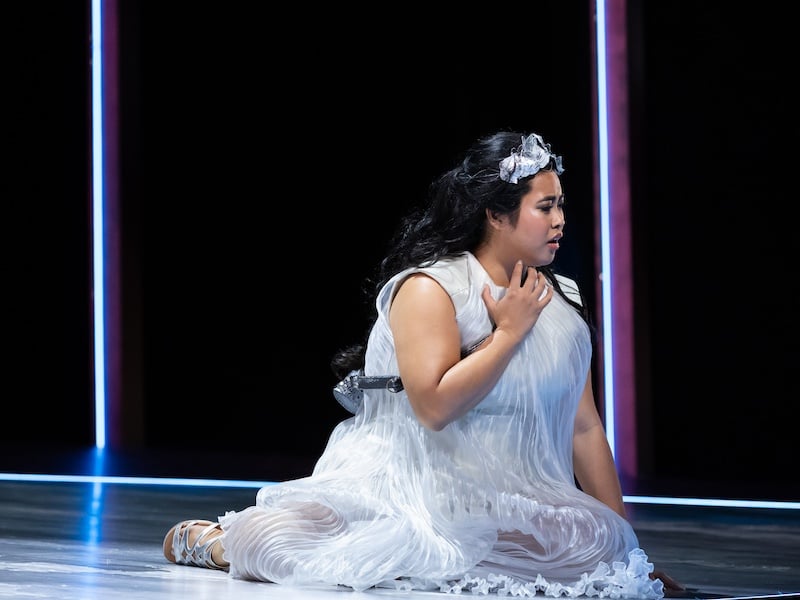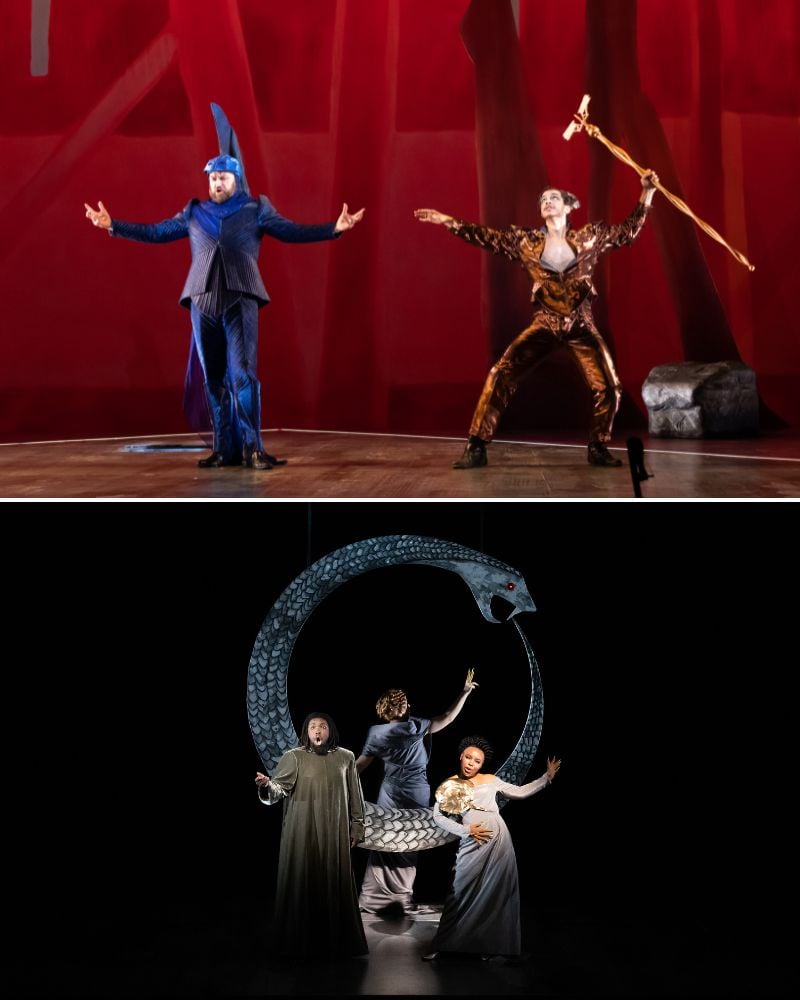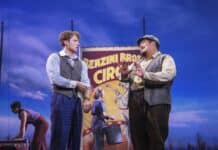Returning to Glimmerglass Festival, nestled on Oswego Lake in Upstate New York and a place of “innovation, creativity, and community” in music theater, felt something of a homecoming for me. There were many passages to mourn but new bright lights to celebrate. Gone was “the little Justice,” Supreme Court Justice Ruth Bader Ginsburg, who was treated here as something of a rock star, buzzed around in a golf cart and held court in a program she anchored on “Opera and the Law.” Gone also is former Artistic Director Francesca Zambello, who for many years juggled the formidable tasks of leading two companies, Glimmerglass and Washington National Opera. But into her shoes at Glimmerglass stepped new Artistic and General Director Rob Ainsley in 2022, and, by all accounts, he has been a successful choice, committing himself full-time to the local community and painstakingly building on the reputation and legacy of Glimmerglass as a premiere summer company to develop opera, its artists, and audiences for the 21st century.

Clearly in his element, Rob Ainsley sat down with me to speak of why this has been a good fit for him. He shared his enthusiasm for making friends in the community and, even more importantly in securing a Glimmerglass future, for cultivating donors. In the off-season, he has already established a great track record traveling coast to coast to hear auditions and scoop up impressive vocal talent to bring into the Festival’s Young Artists Program. He is equally enthusiastic about his admin and production staff. “The team is the best in the country and much of the leadership is women,” he bragged gleefully. “I couldn’t be more proud.”
Ainsley brings fresh energy and a sense of effervescent fun to the job. The first night I attended a program this past weekend, he came out to give his pre-curtain speech wearing a red clown nose and rainbow-colored wig. (Alright, so the show was Pagliacci.) Well played, Rob!
Ainsley also shares a good relationship with the Festival’s music director and principal conductor, Joseph Colaneri. Perhaps because they are both musicians, their long-standing relationship is built on mutual respect and a deep passion for the classical operatic repertoire. One feels they are in sync and imagines that they share the viewpoint that the music in opera comes first and probably should not be overlaid with the heavy mantle of a radical concept. Colaneri provided the second pre-curtain speech of the weekend as “‘Maestro’ Rob Ainsley” was moving “to the podium” in the orchestra pit to conduct La Calisto.
Ainsley had provided the new orchestration for La Calisto and further added to his leadership role by also playing harpsichord with fellow harpsichordist J. Bradley Baker and anchoring the appropriately pared-down instrumental ensemble. (I must also mention that the orchestra included the gorgeous sound of two theorbos, Baroque lute instruments played by Michael Leopold and Adam Cockerham.) To watch Ainsley conduct while playing the harpsichord, doing something of a slo-mo head-banging to indicate the downbeat and move the recitative passages forward, added to the evening’s pleasure and my admiration watching this artist at work.

La Calisto is a Baroque opera written in 1651 by composer Francesco Cavalli with libretto by Giovanni Faustini. It’s a lovely work for the Festival with its generous cast of characters, giving young singers opportunities to shine in solos in music not too heavily taxing on the voice and allowing them to practice special Baroque vocal ornamentation techniques such as the trillo (often referred to as the “goat trill,” a rapidly repeated staccato attack all on one note that sounds a little like bleating).
Set designer Charlie Corcoran framed the entire proscenium in Venetian red with heavy gold architectural ornamentation. There the nod to the past era’s glory ends. Instead, Corcoran has taken the principle of the Baroque passion for symmetry but executed it through a clean, contemporary stage design, using thin neon vertical piping, which is then incorporated into Amith Chandrashaker’s elegant lighting design, changing color throughout the evening, going from red to purple to sky blue, then orange and back to red, and using a similar neon motif in a giant isosceles triangle on the floor. Designer Carlos Soto costumed many in the cast in ravishing jewel-toned fabrics and period silhouettes. Others, such as in the gods’ world, he bedecked as if on a Hollywood red carpet or at a Met Gala.
Director Mo Zhou, recipient of an Opera America 2023 grant for Women Stage Directors, directs the opera with a sense of restraint for the arias, bringing the singers downstage center to let the vocal artistry reign. In this, she also supports a sense of intimacy between singer and audience so that nothing mars a song’s emotional expansion.
The opera is full of disguises and mistaken identities with a plot that constantly shifts focus. Jove, king of the pantheon of Roman gods, descends to earth after some unspecified catastrophe, ostensibly to bring healing, but he is soon up to his old philandering ways with mortal maidens. It seems the harder they are to get, the harder he wants them to fall. In this case, Calisto is a young girl who is dedicated to the goddess Diana and has taken a vow of chastity in her name. So, Zeus visits her in the guise of Diana and promptly seduces her. Meanwhile, the shepherd Endymion has fallen hard for the real goddess. Surprisingly, Diana falls for him and struggles mightily to maintain her celibate reputation.
Desire is a major theme in this opera, and we are shown it gets unleashed and grows exponentially as Pan and a host of nymphs and satyrs manifest their own randy bawdiness. It verges on a Baroque love-in, that is until Juno appears, coming down to earth to rein in her husband Jove’s behavior. It’s an old, hell-has-no-fury tale, and this wronged wife seeks revenge.

Craig Irvin is masterful as Jove with his rich bass notes and superb clarity of diction. Emilie Kealani and Kyle Sanchez Tingzon are the two young principal mortals, and both show they already excel in the pure, agile, and lustrous sound of Baroque opera.
There are other standout performances. Schyler Vargas nearly steals the show as Mercury, Jove’s sidekick and partner in seductions. Dressed in a copper-colored metallic jumpsuit, he carries Mercury’s identifiable caduceus, a kind of magic wand or staff, and plays it as if it were an electric guitar and he a rock star. The chemistry he displays with Irvin makes their relationship something of a boys’-night-out bromance and male predation look like fun. Taylor Raven sings the dual role of Diana and Jove-as-Diana with brilliance and moves between icy goddess and smoldering seductress.
Eve Gigliotti is perfectly cast as Juno, bringing great authority to the role, but she also delivers the pain a woman feels living with a repeated philanderer as a husband. Sadly, we watch the wrathful goddess, much like in our own society, bent on punishing the female victim. The mortal, now impregnated Calisto is cast out in the firmament, “released” as a star.
Namarea Randolf-Yosea makes a wonderful Pan. She and the cast of dancers — Kailee Reagan Brandt, Peter Murphy, Blaise Rossmann, Emma Sucato, and Truman Tinius, under the extraordinary choreographic leadership of Eric Sean Fogel — make the stage come alive with a radical blend of Baroque gesture and red-hot-and-steaming popular dance moves. They become a gorgeously androgynous team and, through a series of quick costume changes, enter the stage transformed into now female nymphs, now “grinding” male fauns and satyrs, now statuesque handmaidens of this or that goddess.
Next year will be the 50th anniversary of the Glimmerglass Festival, which promises once again to advance the art form by programming a taste of the breadth of opera for the 21st century; combining offerings in inherited repertoire and new, crossover works; giving opportunities to young, gifted singer-actors; and mentorship by example of luminaries honing their craft of opera.
Running Time: Two hours and 25 minutes.
The 2024 Glimmerglass Festival continues through August 20, 2024. For tickets and more information visit Glimmerglass.org or call 607-547-2255.
SEE ALSO:
Old meets new in ‘Pagliacci’ and ‘Elizabeth Cree’ at Glimmerglass Festival (reviews by Susan Galbraith, August 5, 2024)




